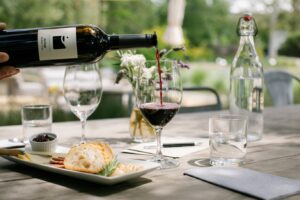In the not very distant past, a typical wine tasting would involve entering a tasting room, finding a space at the bar, getting the server’s attention and sampling a few wines as slowly or as quickly as one pleased. The server would explain what each wine was, very briefly on busy days, with more detail and conversation on slower ones. The trend in wineries these days, particularly but not exclusively in Napa Valley, is to take a seat at a table (by appointment, if you please) and be served a selection of wines by someone who acts more like a waiter than a bartender.
Photo courtesy of Medlock Ames.
In some ways, we like this experience, but in others we miss the way things used to be.
Beginning with the upside, a seated tasting more closely matches the way you would enjoy these wines in your own home. You might stand up and sip some Chardonnay at a party or a barbecue, but the wine would not be the center of attention, nor would the wines in question be of the quality you expect at a wine tasting. Especially if the server offers you something to eat, even a few crackers, you get a better sense of how you would enjoy each wine were you to purchase some.
Almost without exception, the interaction with the servers is cordial and as informative as the server’s knowledge can make it. That’s because they aren’t being pulled from one visitor to the other, trying to serve as many people in as short a time as possible. In the worst days of the pandemic, wineries were forced to seat their customers at widely spaced tables. Finding employees was more difficult as well. Both these trends are still apparent now that Covid has ebbed. As a result, with seated tastings, servers have more time, less pressure and can give their guests more attention.
It must be said that the facilities, in or out of doors, are more attractive. Visitors can look around rather than stand at the bar facing the scurrying servers.
However, there are some negatives. At a bar, if you were served a wine you don’t especially care for, you could pour it out at strategically placed buckets and move on to the next wine. At a table, you may have to ask for a bucket and then wait your turn for the next wine to be served. (A few wineries, such as Duckhorn and Black Stallion, both in Napa Valley, serve the entire flight at one time, so visitors can drink at their own pace.)
Yes, you have more of an opportunity to speak with the servers. What you want from them is their knowledge of wine in general and that winery’s products in particular. But you didn’t come there to hear their life stories, which teams they root for and where their kids are going to school. (Honest, these have happened to us.) One of the big plusses of seated tastings is having the chances to sip at your leisure. Having some stranger dominate your time eliminates that advantage.
Finally, seated tastings take more time, an hour at a minimum but often more. This significantly reduces the number of wineries anyone can visit in a day. That’s a plus for sobriety, but for those who sip and pour, as we do, it’s not so positive. And we find that in sitting and waiting for our servers, we drink more of what’s in front of us than we would have otherwise.
